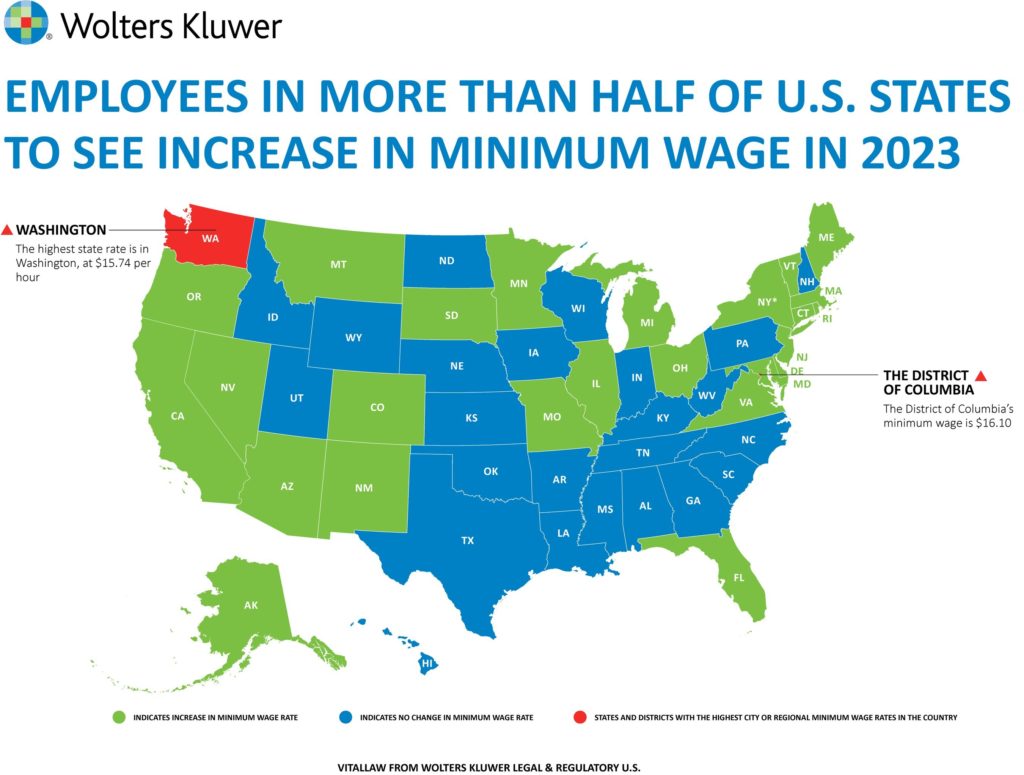Several states across the US plan to increase the minimum wage this year, according to payroll experts.
So far, a total of 26 states have announced minimum wage raises in 2023, and at least one state is likely to see an increase in July, confirmed Wolters Kluwer Legal & Regulatory US.
“The biggest factor in the minimum wage adjustments for 2023 is the high rate of inflation seen in the last year,” said Deirdre Kennedy, Senior Payroll Analyst at Wolters Kluwer Legal & Regulatory US. “Different states are setting their own rules. These include a cap on the percentage the minimum wage can increase – given the intense impact that inflation can have.”
KEY TAKE AWAYS
The firm’s analysis of upcoming minimum wage changes reveals that:
- The highest state rate is in Washington, at $15.74 per hour while the District of Columbia’s minimum wage is $16.10.
- Thirteen states, the District of Columbia and numerous cities and counties tie their minimum wage rate to the Consumer Price Index (CPI), resulting in a significant increase in pay for hourly employees in those areas. Some states have implemented a cap on the percentage that the minimum wage can increase to protect against big jumps in the minimum wage in times of high inflation. More states will begin inflation-based increases in future years after concluding schedules of fixed-rate increases.
- Several states will continue with their scheduled increases to the minimum wage. Both Delaware and Maryland will see an increase of $1.25, reaching $11.75 and $13.25 (for large employers) respectively. Massachusetts’ minimum wage is $15.00 as of 1 January and Connecticut’s will reach $15.00 on 1 June. More states are still on track to reach a minimum wage of $15 per hour within the next few years. This includes states such as New Jersey by 2024; Delaware, Illinois, Maryland (large employers), and Rhode Island by 2025; and Florida and Maryland (small employers) by 2026.
- Michigan may see two increases to its minimum wage in the first two months of 2023. A scheduled increase from the current $9.87 to $10.10 will go into effect 1 January. The laws that established the scheduled increase were struck down by the Michigan Court of Claims. However, returning the minimum wage to that established by two prior voter-initiated laws, which would have brought the minimum wage to $12.00 in 2022 and tied future increases to inflation. The court has delayed the effective date of its ruling to 19 February 2023, at which time the minimum wage will increase to $13.03 per hour should an appeal of the court’s ruling fail.
- Two states and the District of Columbia saw ballot measures affecting minimum wage pass in the November midterm elections. Nebraska voters supported Initiative 433, which increases the state’s minimum wage to $15 per hour. That’s up from $9 per hour, by 2026. The minimum wage will adjust annually based on inflation after 2026. Voters in Nevada approved a measure raising the minimum wage to $12 per hour in 2024. The measure also removes the existing provision that sets different rates for the minimum wage based on whether the employer offers certain health benefits to employees. In DC, voters approved Initiative 82, a ballot measure that eliminates the tip credit by 2027. At that time, tipped employees’ wages will align with wages for non-tipped employees.

MINIMUM US WAGE INCREASES BY STATE
To support employers, labour attorneys and employees across the country, Wolters Kluwer has prepared a comprehensive analysis of legislative updates to outline the states that will raise their minimum wage in the coming years. Upcoming state minimum wage increases can be found in the table below as follows:
| Alaska | $10.85 per hour, up from $10.34 per hour. |
| Arizona | $13.85 per hour, up from $12.80 per hour. |
| California | $15.50 for all employers regardless of size, up from $15.00 for large employers and $14.00 for small employers in 2022. While the hourly minimum wage for small employers (those with fewer than 26 employees) was originally scheduled to rise to only $15 in 2023, California labor law requires the minimum wage for these employers to equal that of large employers (those with 26 or more employees) when the rate of inflation exceeds 7% in the year that the hourly minimum wage for large employers is $15.00. The average consumer price index from July 1, 2021, to June 30, 2022, increased by 7.9%. |
| Colorado | $13.65, up from $12.56. |
| Connecticut | $14 per hour, scheduled to increase to $15 on June 1, 2023. |
| Delaware | $11.75 per hour, up from $10.50, pursuant to legislation signed in July 2021 that will increase the minimum wage to $15.00 by 2025 (S.B. 15, L. 2021). |
| Florida | $11.00 per hour, up from $10.00. Wage rates are adjusted annually based on inflation. A constitutional amendment approved by voters in the November 3, 2020, General Election will increase the minimum wage to $12.00 on September 30, 2023, and to $15.00 by 2026. |
| Illinois | $13.00 per hour, up from $12.00. The minimum wage is scheduled to reach $15 in 2025. |
| Maine | $13.80 per hour, up from $12.75. |
| Maryland | In 2023, the minimum wage is $13.25 for large employers (up from $12.50) and $12.80 for small employers (up from $12.20), increasing at different increments to reach $15 in 2025 for large employers and in 2026 for small employers. |
| Massachusetts | $15.00 per hour, an increase of 75 cents. |
| Michigan | $9.87 per hour increasing to $10.10 January 1, 2023, and (possibly) to $13.03 on February 19, 2023. (The Michigan Court of Claims struck down a legislative amendment to two voter-initiated laws that brought the state’s minimum wage to $12.00 by 2022. The voter-initiated law was thus reinstated, with an effective date of February 19, 2023. The law tied minimum wage increases to inflation beginning in 2023, which would set the minimum wage at $13.03 in 2023, pending the outcome of an appeal of the court’s decision.) |
| Minnesota | $10.59 per hour (up from $10.33) for employees of large employers with an annual gross volume of sales not less than $500,000. Small employers must pay employees a minimum wage of at least $8.63 per hour (up from $8.42). |
| Missouri | $12.00 per hour, up from $11.15 per hour. |
| Montana | $9.95 per hour for businesses with annual gross sales of more than $110,000. Wage rates are adjusted annually based on inflation. |
| Nevada | $10.50 per hour for employees who do not receive health benefits, to increase to $11.25 on July 1, 2023. $9.50 per hour for employees who do receive health benefits, to increase to $10.25 on July 1, 2023. |
| New Jersey | $14.13 per hour for most employees, up from $13.00 per hour. The minimum wage had been scheduled to reach $14.00 per hour in 2023 but was adjusted due to a significant increase in the Consumer Price Index. The minimum wage for direct-care workers in long-term healthcare facilities is $3 higher than the state minimum wage (A 4482, L. 2020). |
| New Mexico | $12.00 per hour, up from $11.50. |
| New York | Tiered/Rates vary by region: $15 per hour in New York City and in Nassau, Suffolk, and Westchester counties; $14.20 per hour in the remainder of the state. Effective October 1, 2022, the minimum wage for home care aides as defined in New York’s Public Health Law §3614-c increased by $2 per hour above the basic minimum hourly rate. The minimum wage for workers in fast food establishments is $15 per hour in all of New York state. The minimum wage at all airports (LaGuardia, JFK, and Newark Liberty International) reached $19.00 in 2023. |
| Ohio | $10.10 per hour, up 80 cents from $9.30 per hour. Wage rates are adjusted annually based on inflation. The minimum wage rate applies to employees of businesses with annual gross receipts of $372,000 per year (changed from $342,000 in 2022). For employees at smaller companies and for 14- and 15-year-olds, the state minimum wage is $7.25 per hour, which is tied to the federal rate. |
| Oregon | The state minimum wage is tiered, with the highest rate in the Metro Portland area at $14.75 per hour, the lowest in rural (non-Urban) areas at $12.50 per hour, and a “standard” minimum wage of $13.50 per hour in the rest of the state. Starting July 1, 2023, the minimum wage in Portland will be set at $1.25 over the standard minimum wage, and the non-Urban rate will be set at $1 less than the standard minimum wage. Also starting July 1, 2023, the minimum wage adjustment will be tied to inflation. |
| Rhode Island | $13.00 per hour up from $12.25. The state minimum wage will reach $15.00 per hour in 2025. |
| South Dakota | $10.80 per hour, up 85 cents from $9.95 per hour. Wage rates are adjusted annually based on inflation. |
| Vermont | $13.18 per hour. This is a 63-cent scheduled increase over the $12.55 per hour 2022 rate. |
| Virginia | $12.00 per hour, up from $11.00. The increase is part of a series of scheduled increases to reach $15.00 per hour by 2026. |
| Washington | $15.74 per hour. Workers under 16 years old can be paid 85 percent of the adult minimum wage, or $13.38 per hour, in 2023. |






































